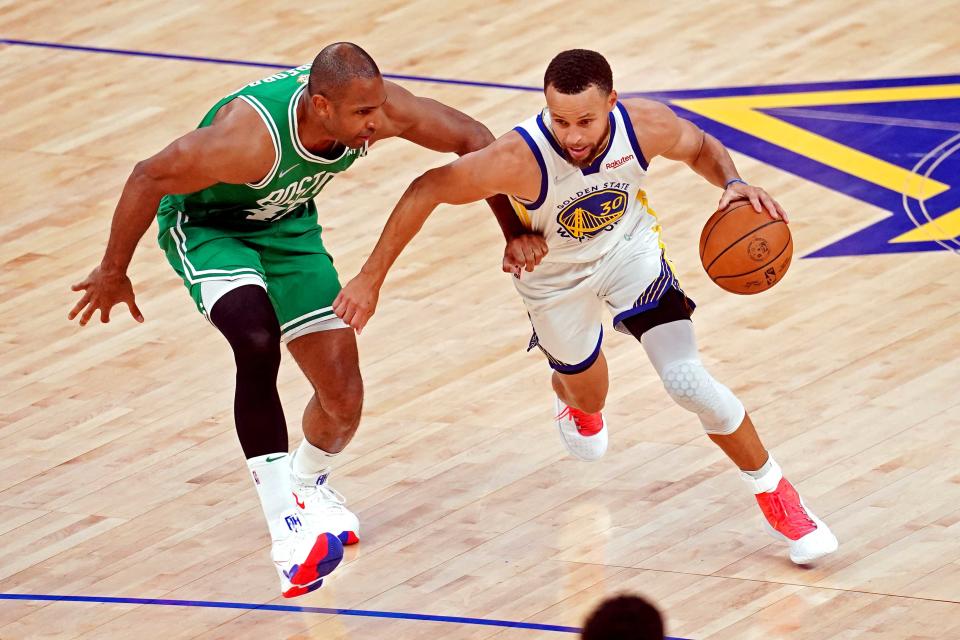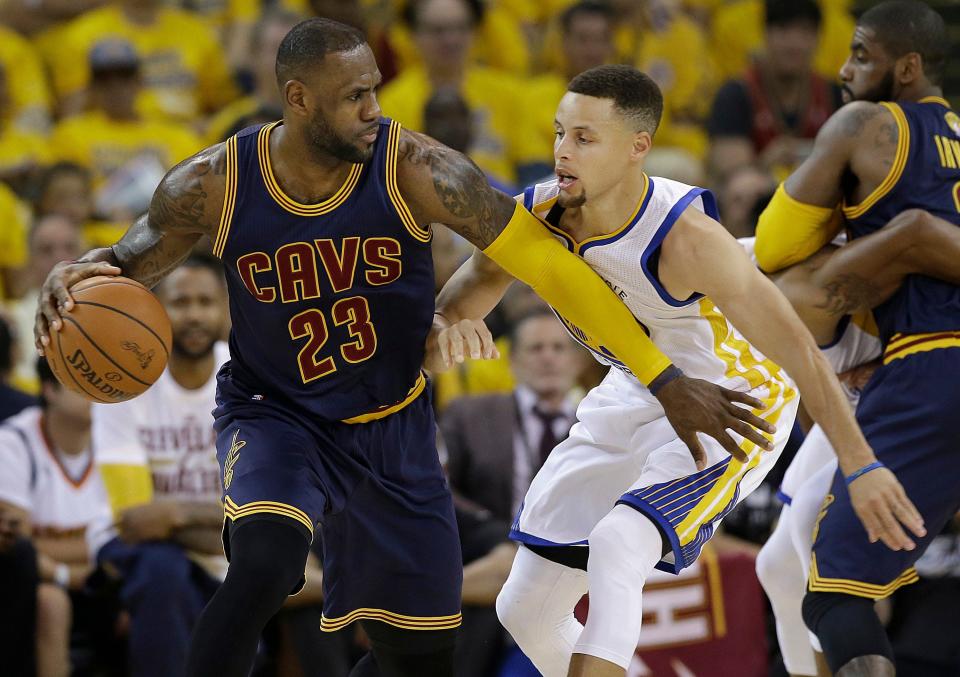SAN FRANCISCO — Golden State’s Draymond Green had the basketball at the top of the 3-point line with Boston’s Al Horford guarding him in the first quarter of Game 2 of the NBA Finals on Sunday. Green handed off the ball to Steph Curry and set a screen on Curry’s defender, Marcus Smart.
Smart fought through the screen, so Green set another, finally forcing the defensive switch Golden State wanted: Horford guarding Curry. With a pump fake that fooled Horford, Curry leaned in for a floater from the free-throw line, his first points of the game.
The Warriors on that particular sequence were matchup-hunting, a philosophy based on attacking a favorable matchup for the offense. Golden State wanted the smaller, quicker Curry to break down the taller, slower Horford.
SPORTS NEWSLETTER: Sign up now for daily updates sent to your inbox
THE TALK: Steph Curry’s defense as important for Warriors as his offense
‘THE HOLY GRAIL’: 1-of-1 LeBron James card – pursued by Drake – goes to auction; will fetch millions

While taking advantage of mismatches has always been a part of basketball, this persistent dedication to giving a talented offensive player an opportunity to exploit a weaker defender has grown in recent seasons.
“It feels like it wasn’t this way when I first started coaching eight years ago,” Warriors coach Steve Kerr said. “I think maybe over the last five or six years, it’s gotten more and more popular as we’ve had more and more 3-point shooting (and) more five-out lineups because the floor is so open. And all the switching, it’s hard to attack switches. I think that’s the reason for the hunting over the last few years.”
It’s often utilized in pick-and-roll situations when the defense switches defenders on the screen.
“You’re trying to find advantages in the margins if you can create some kind of separation or advantage in the pick-and-roll with a certain matchup,” Miami Heat coach Erik Spoelstra said. “Every team will try to maximize that.”
There is not a perfect line tracing this NBA-centric phenomenon from its origin to present-day usage. James Harden in Houston under then-Rockets coach Mike D’Antoni sought favorable matchups where Harden could either take a defender off the dribble or shoot a 3-pointer, and in the 2016 Finals, LeBron James, then with Cleveland, went after Curry. It was a size and strength advantage.

To a certain extent, the Celtics want to do that to Curry in this season’s Finals. But Curry has improved as a defender, and he’s stronger, a point Green made after the Warriors’ 107-88 victory in Game 2.
“Teams used to try to call him into every action, and just try to pick on him,” Green said. “That doesn’t work anymore. He sits down, he guards and we all are there behind him if he does need help. But he hasn’t been needing that often, and it’s great.
“I’ve spoken about how much stronger he is. He’s able to hold his ground, so you’re not able to bump him off his spot, and that’s been huge for us. I’m not shocked he’s playing that type of defense. He’s been doing that, like I said, for the last couple years.”
That doesn’t mean Boston isn’t trying. “We like Jayson (Tatum) and Jaylen (Brown) in certain matchups also, although they can score on quality defenders as well. It’s part of the game,” Celtics coach Ime Udoka said.
But these are two stout defenses – Nos. 1-2 in the regular season – and they have counteractions to what the offense is trying to do.
“For the most part, we like to pride ourselves on having no pick-on guys – quality defenders – but that’s not the case with most teams,” Udoka said. “We try to keep our best five defenders on the court where we can switch a lot and not have a lot of dropoff.”
Udoka’s point resonates around the league. Executives are looking for length and skill. As Kerr put it: “It’s never been more difficult to defend in the NBA than today because of all that ground you have to cover. That’s why everybody’s after the 6-8 athletic guy with a 7-2 wingspan who can guard five positions and also shoot a three. That’s the most coveted player out there these days, and if you can get a bunch of them, then you’re in business. … That’s what everybody around the league is trying to do.”
The great offensive players just don’t look to score. On those pick-and-rolls, they frequently draw double-teams, creating a player who is open for a shot. James has mastered this. He not only looks for his mismatch, he looks for a teammate’s mismatch on the switch. When two defenders follow James or Harden, they pass to the open play. That’s why they compile so many assists.
Even during an off-night shooting in Game 1, Tatum had 13 assists. He’s a gifted scorer, and he demands attention, but he’s such an improved playmaker he can find open shooters.
Turner Sports analyst and former NBA coach Stan Van Gundy has watched this development evolve from isolation basketball where players drained the shot clock and then tried to make something happen before the 24-second shot clock expired. He saw players like Reggie Miller and Ray Allen move off the ball using screens to get free for jump shots.
“The only way you’re going to get two guys on the ball and create shots is to beat people one-on-one off the dribble and force help,” Van Gundy said. “And to do that, to be able to beat people one-on-one, you’re going to need those favorable matchups.”
Van Gundy said the idea of hunting matchups is two-fold. Not only are they looking for an offensive advantage, they’re trying to wear a player down defensively so he’s not as effective offensively.
“It’s just not attacking a favorable matchup, it’s also ‘We want to make the other guys work,’ ” Van Gundy said. “So hopefully take away some of his effectiveness on the other end. It’s not just saying, ‘Chris Paul can’t defend.’ It’s saying, ‘Chris Paul is 37 years old, they depend on him heavily to make plays, we’re going to wear on this guy every way we possibly can.’ ”
Miller, also a Turner Sports analyst, mimicked Van Gundy with one of his customary boxing analogies.
“You have to treat this like a prize fight,” Miller said. “The first couple of rounds, it’s sticking and moving, jabbing, seeing what you can get away with. But once you get into seventh, eight, 10th rounds and you’ve been clutching and holding, and you’re 10, 15, 20 pounds heavier than your opponent, that’s when you look for your knockout. That’s what we see a lot of these teams doing now in terms of searching for these matchups they want.”
This article originally appeared on USA TODAY: How Celtics-Warriors NBA Finals showcases matchup ‘hunting’ trend




